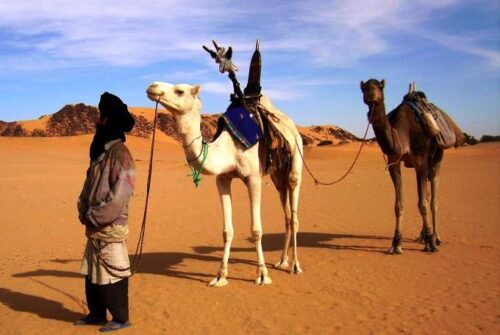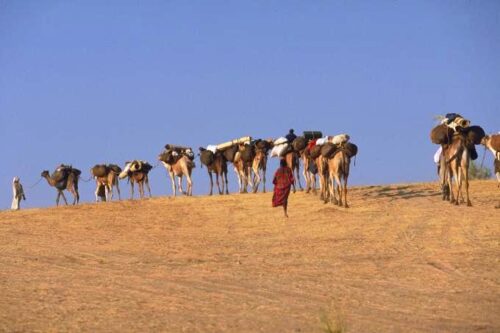Archaeology and History in the Sahara / A Journey to Tadmekka.
In Mali seeking the ancient capital of the Tuareg. It was once one of the most populated and richest of the trans-Sahara cities
in West Africa.
Tuareg: the mythical name means ŌĆśabandoned by GodŌĆÖ, the name which the medieval Arab conquerors gave to the nomads of the desert. However, the local name of these people is Kel Tamacheq, those who speak tamacheq, an ancient Saharan language with its own script called Tifinagh. Their continual movement from north to south and back again, with the dry and wet seasons, in search of the meagre pastures to be found in the desert, led them to be known as ŌĆśsons of the cloudsŌĆÖ. In Malian Sahara, on the border with Algeria, there is a mountainous massif 1,000 metres high and made of basaltic rock and stone: the Adrar des Ifoghas. On this massif, whose capital is Kidal, we find four-thousand-year-old cave paintings due to the place having been crossed by the most frequented trans-Saharan trade routes.

In the Middle Ages, along one of the now-extinct waterways (wadi), a group of Tuareg from Hoggar (Algeria), founded Tadmekka, a rich acculturated city, mentioned and magnified in many of the accounts of medieval Arab travellers. As the centre of trans-Saharan commerce, it was called es-Souk (the market), and its magnificence only began to wane with the emergence of Timbuktu at the end of the Middle Ages.
In 1640, Tadmekka was destroyed by a faction of Tuareg enemies, and the city was forgotten until the 1800s, when a French archaeological expedition reached the ruins of that city in the middle of the desert.
A further two expeditions went to es-Souk in 1935 and 1952. In 1960, when Mali became independent, Adrar was declared a military site and inaccessible to foreigners.

Es-Souk was explored for the first time only at the start of the 2000s, much later than the other trans-Saharan commercial cities, partly due to the civil disorder in Mali in the nineties. The digging began exactly in 2005, guided by the Missione Culturelle Es-Souk, Malian Institut des Sciences Humaines, and Direction Nationale du Patrimoine Culturel. Over the years, there was a series of archaeological expeditions that sought to discover the historical roots of the Tuareg people. Today, due to the instability of the place, archaeological research has been halted.
Es-Souk ŌĆö The market
As regards Tadmekka, there are various Arabic sources that mention it. This city is spoken of by the Arab historian Ibn Khaldun (1332-1406) and by the more ancient Arab geographer el-Bekri (1028-94) who says that, on the Niger, (in an unspecified city of Tiracca) there was an exchange of products coming from Ghana and Tadmekka, in the Adrar des Ifoghas. El-Bekri describes Tadmekka as ŌĆ£Of all the cities in the world, it most resembles MeccaŌĆØ. Tadmekka was on a route leading, after forty days, from Ghadames (Libya) to Gao (Mali), and the inhabitants of the time used to buy millet in Gao.The origin of this city (whose ruins are close to the present-day site of es-Souk, to the north-west of Kidal) predates the arrival of the Arabs and originates probably from the middle of the first millennium of our era.

View of the Essouk Valley, the location of the Tadmekka ruins. (Photo: Sam Nixon).
The urban criteria followed in its development lead to the idea of sedentary populations. The presence of a river and a commercial route between the markets of the Mediterranean coast and the River Niger rendered the area most favourable. Given that the derivation of the appellative Tadmekka predates the Islamisation of the area, the name does not derive from that of Mecca to which the geographer el-Bekri renders it similar but derives from an ancient Berber tribe, the Tademkiun, and the city may have previously had a different name.
In the late Middle Ages, some of the inhabitants of Tadmekka moved southwards towards the bend of the Niger and, in the XII century, founded Timbuktu. The commercial importance of Timbuktu to Tuareg trade led to it eclipsing Tadmekka and it was finally destroyed by the Iullimmiden Tuareg.
The position of Tadmekka, apart from its commercial value, was strategic from the morphological point of view: the city developed in a valley with steep sides some tens of metres high that provided sound defence and observation points.
The ruins of the necropolis
Along the banks of the es-Souk wadi, a river once navigable and with plenty of fish, there is a vast array of stone blocks. From above, however, one may make out geometric shapes with ancient pathways and house foundations. The ruins are one kilometre long.
The simple structure of the quarters farthest from the river indicates that they were inhabited by the poorer classes, and it is here that the lodgings are found where passing merchants and their dromedaries could rest and quench their thirst.

The base of the walls. (Photo: Sam Nixon).
In the centre of the wadi, there is a former island; here the constructions are in a better state of preservation, the houses are spacious with communicating courtyards in what was probably an area inhabited by the noble classes. Along the bank of the island, a low wall was built in stone blocks to protect the houses from river floods.
The few investigations carried out by archaeologists in the inhabited area did not lead to the discovery of the emporiums, the forges, or the industries renowned throughout the Sahara, or the mint that once struck famous gold coins. These ruins, which perhaps lie under the sand, would enable the reconstruction of the appearance of the city just as the medieval Arab travellers saw it.

The whispering harmattan leads the imagination to clearly hear the rushing waters of the river and the cries of the fishermen, the clanging of the blacksmiths, the chattering of the market and the laughter of children – sounds that, centuries ago, filled the clear air of a more moderate climate and the days of this opulent city ŌĆō at the crossroads of one of the most important trans-Saharan merchant routes.
In Tadmekka, there are six cemeteries, generally within enclosed areas. Most of the tombs are Islamic and only a few predate the Islamic period. The inscriptions on the tombstones are written in Arabic script and the tombs are made of circles of stones within which, when the skeleton of the dead person emerges from the sand, the face can be seen pointing towards the east.
On the higher areas in the north-west (which dominate one of the cemeteries), Tifinagh inscriptions can be seen as well as paintings of domestic and wild animals such as dromedaries, giraffes, and fish, that testify to a once moderate climate and abundant fauna that ensured the wellbeing and tranquillity of the inhabitants. (View across the central area of Tadmekka/Essouk, showing extensive stone ruins on the surface. Photo: CC BY 3.0/Journal of Archaeological Science.)
Gian Andrea Pagnoni



